Welcome to the mesmerizing world of resin art! If you’ve ever marvelled at those stunning, glossy pieces that seem to capture light and color in a magical way, then you’re in for a treat. Resin art is an incredibly versatile and captivating form of artistic expression that allows you to create unique masterpieces with endless possibilities.
Whether you’re an experienced artist looking to try something new or a complete beginner curious about this fascinating technique, this blog post will provide you with all the tips, techniques, and inspiration you need to dive into the enchanting realm of resin art. So grab your apron and let’s get started on your next creative adventure!
Different Types of Resin
Resin art is a fascinating and versatile form of artistic expression that allows you to create stunning pieces with depth, shine, and vibrant colours. But did you know that not all resins are the same? There are different types of resin available in the market, each with its own unique properties and characteristics.
Epoxy resin is one popular type used in resin art. It is known for its high gloss finish and excellent adhesion to various surfaces. Epoxy resin can be poured thickly or thinly depending on your desired effect, making it perfect for creating beautiful layers and intricate designs.
Polyester resin is another option commonly used in artwork. It has a fast curing time which allows for quicker turnaround on projects. Polyester resin also offers good clarity and UV resistance, making it suitable for outdoor applications like garden sculptures or jewellery pieces.
Urethane resins are often chosen by artists who want to create flexible or semi-flexible objects. These resins have excellent impact resistance and durability, making them ideal for creating functional items such as phone cases or wearable accessories.
Silicone mould-making resins are specifically formulated to make moulds for casting other materials like concrete or wax. They have excellent tear strength and flexibility, ensuring the easy release of the casted item from the mould without causing any damage.
These are just a few examples of the different types of resin available out there. Each type has its own strengths and weaknesses, so it’s important to choose the right one based on your specific needs and desired outcome. Experimenting with different types can open up new possibilities in your resin art journey!
Tips and Techniques for Creating Resin Art
Resin art is a captivating form of artistic expression that allows you to create stunning and unique pieces. Whether you’re a beginner or an experienced artist, here are some tips and techniques to help you take your resin art to the next level.
1. Preparation is key: Before starting your resin art project, make sure to properly prepare your workspace. Cover surfaces with plastic sheets or wax paper to prevent any accidental spills from damaging furniture or floors.
2. Choose the right type of resin: There are different types of resin available, such as epoxy resin and UV resin. Each has its own properties and curing times, so it’s important to choose the one that best suits your needs.
3. Measure accurately: To ensure successful results, it’s crucial to measure the resin and hardener accurately. Use measuring cups or syringes specifically designed for resin mixing.
4. Mix thoroughly: Properly mixing the resin and hardener is essential for achieving an even distribution of color pigments (if used) and avoiding air bubbles in your artwork. Stir gently but consistently until both components are fully combined.
5. Experiment with additives: You can add various materials like alcohol inks, acrylic paints, glitter, or even dried flowers into your resin mixture to create interesting effects and textures in your artwork.
6. Practice layering techniques: Layering different colors of pigmented resins can produce stunning depth and dimensionality in your artwork. Ensure each layer is cured before adding another layer on top, to avoid blending colors together.
7. Use a heat gun torch: To remove any unwanted bubbles trapped within, you can use a heat gun/torch shortly after pouring.
Equally, distribute heat across the surface by moving the tool continually back-and-forth above the surface.
Avoid heating too much as this may cause yellowing or burning.
Remember that creating beautiful resin art takes practice! Don’t be afraid to experiment with different techniques and materials to discover your own unique style. The more you explore,
Inspiration for Your Next Resin Art Project
Looking for some inspiration to kickstart your next resin art project? Look no further! The possibilities with resin are truly endless, and there’s no shortage of ideas to get those creative juices flowing. Whether you’re a beginner or an experienced artist, exploring different sources of inspiration can take your resin art to the next level.
One great source of inspiration is nature. Take a stroll through a park or hike in the woods and observe the beautiful colors and textures found in flowers, leaves, and even rocks. These natural elements can serve as the perfect muse for your resin creations.
Another idea is to draw inspiration from other artists. Browse through online galleries or visit local art exhibitions to see what others have created using resin. You might come across unique techniques or color combinations that spark your own creativity.
Don’t limit yourself to traditional canvas shapes either. Resin can be poured onto various surfaces such as wood panels, coasters, jewellery moulds, and even furniture pieces like tables or countertops. Experimenting with different surfaces can open up new avenues for artistic expression.
If you’re feeling adventurous, try incorporating other materials into your resin art. Consider adding dried flowers, feathers, shells, or glitter for added dimension and visual interest. Mixing mediums can result in stunning effects that make your artwork truly one-of-a-kind.
Don’t forget about experimenting with color schemes! Resin allows you to create vibrant hues by mixing pigments or using alcohol inks. Play around with contrasting colors or opt for a monochromatic palette – whatever speaks to your personal style!
Remember: finding inspiration is all about keeping an open mind and letting your imagination run wild! So go ahead – dive into this exciting world of resin art and let these ideas inspire you on your creative journey
Where to Buy Supplies for Resin Art
Now that you’re brimming with ideas and inspiration for your next resin art project, it’s time to gather the necessary supplies. Fortunately, there are several places where you can find everything you need to bring your artistic vision to life.
1. Online Retailers: One of the most convenient options is shopping online. There are numerous websites dedicated specifically to selling resin art supplies. These platforms offer a wide range of products, including different types of resin, pigments, moulds, tools, and more. The advantage of online shopping is that you have access to a vast selection from various manufacturers and suppliers worldwide.
2. Local Craft Stores: If you prefer browsing physical stores or want immediate access to your supplies without waiting for shipping times, local craft stores can be a great option. Many arts and crafts retailers carry resin art materials in their inventory. By visiting these stores personally, you can also get recommendations from knowledgeable staff members who might provide valuable insights and suggestions for your projects.
3. Specialty Art Supply Shops: Another excellent resource for finding high-quality resin art supplies is speciality art supply shops. These establishments focus specifically on catering to artists’ needs by offering an extensive array of materials tailored towards various mediums – including resin art! Not only will they have all the essentials like resins and pigments but also specialized tools designed explicitly for working with resin.
4. Make Your Own Tools: While buying pre-made tools certainly has its advantages in terms of convenience and quality assurance; some artists enjoy creating their own custom tools instead. This allows them complete control over every aspect of their artwork while giving them an opportunity 0to infuse their personal touch into each piece.






